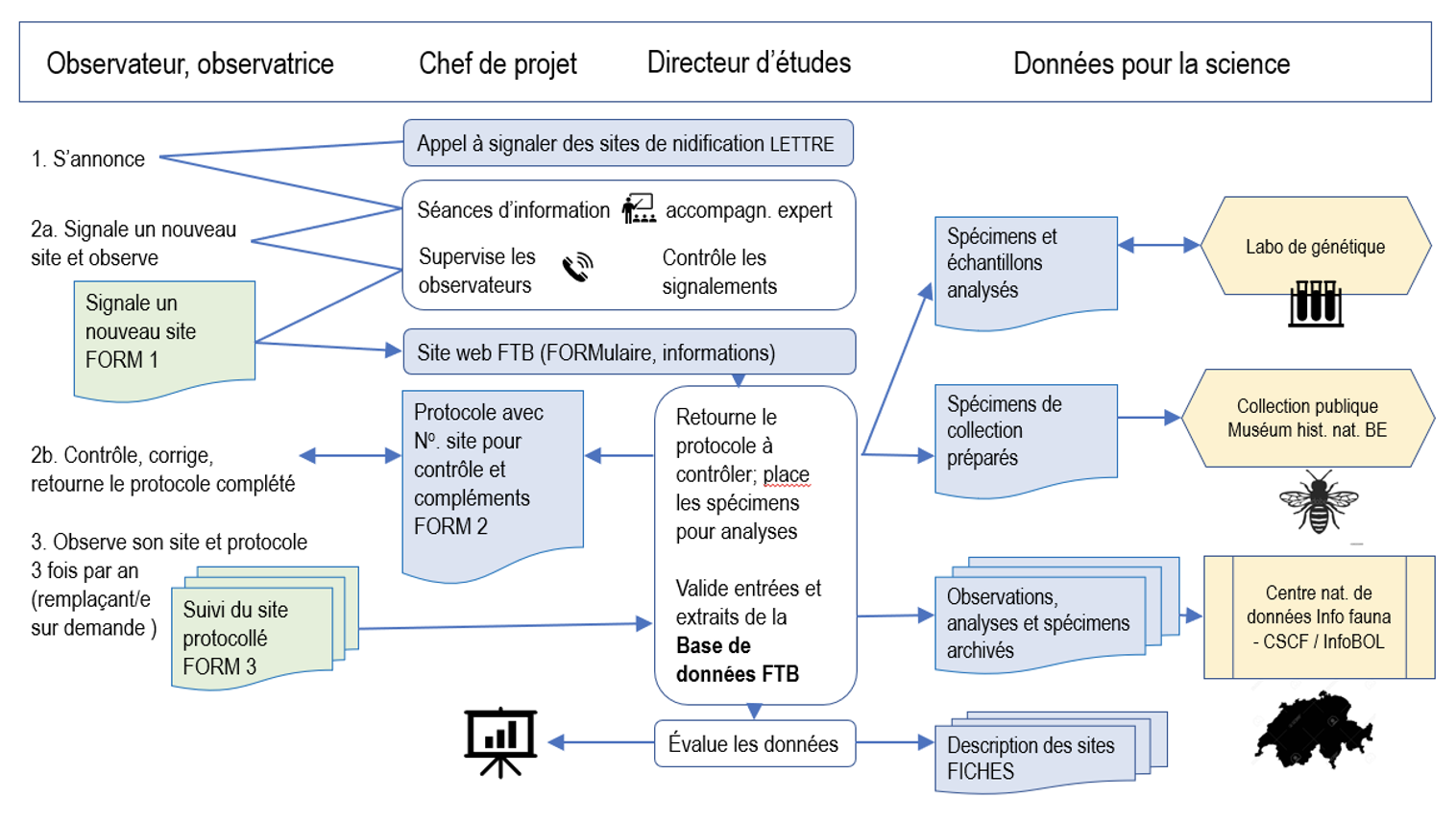Swiss BeeMapping 2021 to 2023
Our research question:
Where in Switzerland are there honey bee colonies living in the wild that can survive without management?
Our Action:
We map wild honey bee colonies and check the reported locations in spring, summer and autumn.
Swiss BeeMapping is a Citizen Science project:
Volunteers observe honey bee colonies and record field data.
Information events with an introduction to the mapping project will take place online in February / March 2021
The first field inspection starts in spring (March / April), scientifically accompanied and instructed
Registration with the project manager Swiss BeeMapping: andre.wermelinger@freethebees.ch



The latest information
Take part in the first survey of honeybees living in the wild in Switzerland!- Call for participation in the Citizen Science Project Swiss BeeMapping ( Lien vers le pdf )
- Current information for employees ( Link )
What does it concern?
The western honeybee Apis mellifera L. is originally a wild bee species that is widespread in Europe. Cultivated by man since ancient times, it has now been spread all over the world. Current studies in Europe and overseas show that honeybee colonies are not only kept in managed apiaries as “pets”, but are left on their own and still live in the wild without additional feeding. That honey bee colonies in France and Germany can survive in the wild and without management has been scientifically proven, but not yet in Switzerland. The occurrence of honey bees in the forests of Europe is estimated at more than 80,000 colonies. Neither in public collections nor in the data center for the fauna of Switzerland (Info fauna – CSCF) is there any evidence of honeybees living in the wild. The Swiss wild bee specialists assume that the western honey bee has become extinct in its original status as a wild bee species. For Switzerland it is therefore generally assumed that sighted swarms come from managed apiaries, and cannot survive without human care. However, the FREETHEBEES association has regularly received reports of sightings of free-living colonies for many years, which may be considered an indication. FREETHEBEES sightings have now been reported in almost 30 municipalities in the cantons of AG, BE, FR, LU, NE, SG, SH, SO, TG, VD and ZH. These have not yet been scientifically investigated and checked. The existence of free-living honeybee populations is very likely of essential importance for the preservation of their species, and their ability to adapt to environmental changes: It can be assumed that free-living honeybees perform particularly well under natural selection. Better knowledge about free-living colonies, their natural behavior and their demands on the habitat will provide important impulses for their protection as well as for beekeeping. Based on the hypothesis that there are honey bees living in the wild in Switzerland as a result of the reports collected so far, FREETHEBEES has started the project Swiss BeeMapping. In the next three years, from 2021 to 2023, we will be looking for answers to these questions:- Where can you find free-living honey bee colonies in Switzerland?
- What are their nesting sites and how do they behave (feeding, swarming, moving in and out)?
- Do they survive in the great outdoors without management?
How does Swiss BeeMapping work?
The mapping project Swiss BeeMapping was carried out by entomologist Dr. Francis Cordillot developed by ecolingua, motivated by recent studies in Germany and France. The pilot project will start in 2021: on the one hand, with the systematic, scientific review of the reports we have received and are continuously receiving from the various cantons, and on the other hand, with the establishment of a monitoring system for observing wild colonies over several years. In the context of this project, the term “free-living honey bee colonies” refers to those colonies surviving outside of managed honey-production apiaries without care and without intervention. Both those locations with free-living honey bee colonies that have been observed over the long-term, as well as feral colonies swarming out of apiaries are recorded. The latter can nest in a tree cavity, a rock, under eaves, in a wall, chimney or a hollowed out tree trunk (log hive), neglected commercial hives, and naturalistic hives like a SwissTree or Schiffertree, etc. The mapping project Swiss BeeMapping is organized as aCitizen Science Project. A team of volunteers (Citizen Scientists) will observe the colonies and collect data: those interested in nature, professional groups from forestry, rangers of protected areas and parks, members of entomological associations and other volunteer workers. The field data are collected in found colony and observation reporting forms. Photographs are taken and, if possible, bees (including dead ones) are collected and sent in from each location. The scientific evaluation is carried out periodically after feedback has been received. The Swiss BeeMapping project can be viewed on the website, and reports will also be published in the bulletin. Synergies with ongoing monitoring programs in France (V. Albouy, F. Requier) and Germany (J. Tautz, PL Kohl, B. Rutschmann) via Luxembourg (J. Park, C. Zewen) to overseas (T. Seeley) and in Switzerland (P. Neumann, S. Rogenstein) should be used. This broad cooperation will improve the data set and allow in-depth analyzes, for example on questions about the habitat conditions for wild honeybees. The general population should receive an answer to the question of whether honey bees have survived without commercial beekeeping, and whether they can survive in Switzerland in the future. Biodiversity research as well as practice in nature conservation and beekeeping will benefit from the results of Swiss BeeMapping.
Swiss BeeMapping Observation report – cycle of information flow

Literature
Albouy V. 2019. Abeilles mellifères à l’état sauvage – Une histoire naturelle. Ed. de Terran, Coll. Alternatives apicoles:336. Browne K.A. et al. 2020. Investigation of free-living honey bee colonies in Ireland. Journal of Apicultural Research, DOI: 10.1080/00218839.2020.1837530 Büchler R. et al. 2014. The influence of genetic origin and its interaction with environmental effects on the survival of Apis mellifera L. colonies in Europe. J. Apic. Res. 53:205–214. De La Rúa P., Jaffé R., Dall’olio R., Muñoz I., Serrano J. 2009. Biodiversity, conservation and current threats to European honeybees. Apidologie 40:263–284. Hassett J. et al. 2018. A significant pure population of the dark European honey bee (Apis mellifera mellifera) remains in Ireland. Journal of Apicultural Research 57 (3):337-350, DOI: 10.1080/00218839.2018.1433949 Kohl P.T. & B. Rutschmann 2018. The neglected bee trees: European beech forests as a home for feral honey bee colonies. PeerJ 6:e460; https://doi.org/10.7717/peerj.4602 Loftus J. C., Smith M. L., Seeley T. D. 2016. How Honey Bee Colonies Survive in the Wild: Testing the Importance of Small Nests and Frequent Swarming. PLoS One 11:e0150362. Neumann P., Blacquière T. 2017. The Darwin cure for apiculture? Natural selection and managed honeybee health. Evol. Appl. 10:226–230. Oleksa A., Gawroński R., Tofilski A. 2013. Rural avenues as a refuge for feral honey bee population. J. Insect Conserv. 17:465–472. Parejo M., Wragg D., Henriques D., Charrière J.-D., Estonba A. 2020. Digging into the genomic past of Swiss honey bees by whole-genome sequencing museum specimens. Genome Biol. Evol. evaa118. Pollinis. 2018. Statement of Principle for the Protection of Indigenous Honey Bees in Europe. https://www.pollinis.org/publications/statement-of-principle-protection-on-subspecies-and-ecotypes-of-honey-bees/ Requier F. et al. 2019. The Conservation of Native Honey Bees Is Crucial. Trends Ecol. Evol. 34:789–798. Requier F. et al. 2020. Contribution of European forests to safeguard wild honeybee populations. Conservation Letters 13(2). https://doi.org/10.1111/conl.12693 Seeley T.D. et al. 2015. A survivor population of wild colonies of European honeybees in the northeastern United States : investigating its genetic structure. Apidology 46:654-666. https://doi.org/10.1007/s13592-015-0355-0 Seeley T. D. 2019. The lives of bees: the untold story of the honey bee in the wild. Princeton University Press. Thompson C. 2012. The health and status of the feral honeybee (Apis mellifera sp) and Apis mellifera mellifera population of the UK. Thesis. University of Leeds.
